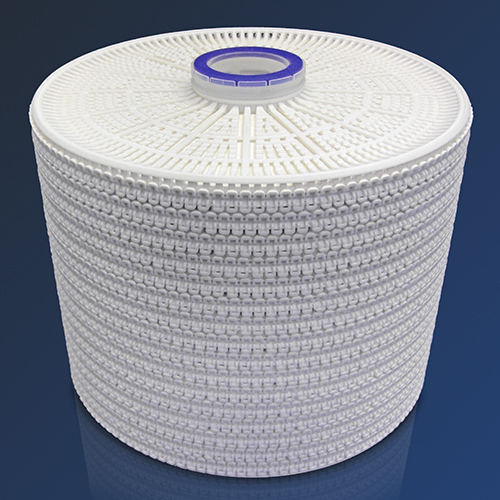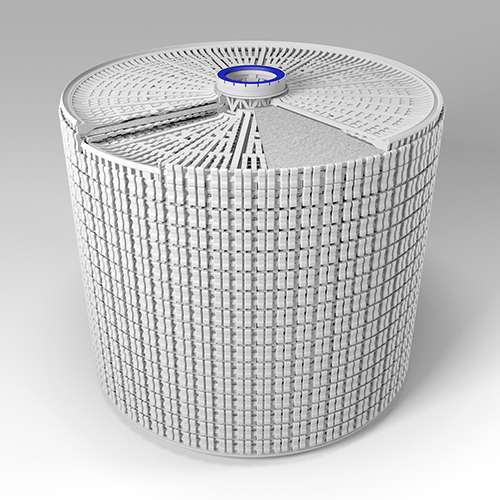B) SUPRAdisc II Modules
Introduction
Stacked disc modules have a long history in Food and Beverage applications. They arose from the need to package sheet-based depth filter technology in a more user-friendly, modular closed system, especially for small batch productions or medium flow rate applications. Due to the relatively high dirt holding capacity and filtration performance of filter sheet-based products, they provide an optimal and cost-effective solution for handling food and beverage fluids.
The filtration effect of these sheet-based products is based on a combination of surface, depth and adsorptive filtration. Selected combinations of cellulose, different types of filter aids or other ingredients in the filter matrix result in highly porous structures that achieve effective filtration, including coarse to fine particle removal, colloidal removal and final filtration.
Classic stacked disc modules represent first-generation module design, but they have performance disadvantages.
SUPRAdisc II modules eliminate the disadvantages of classic stacked disc modules. The depth filter module housings offer increased capacity, reliability, handling advantages and robustness, satisfying customer needs and requirements for a higher-performing product.
The SUPRAdisc II depth filter module housing is ideal for many food and beverage applications.
Basic Construction of Classic Stacked Disc Modules
To better appreciate SUPRAdisc II depth filter housings' design advancements, an understanding of the basic features and construction of the stacked disc modules should be considered.
Since their inception, classic stacked disc modules have been manufactured leaving the cells of media fully exposed within the filter housing (Figures 1 and 2).
- Individual cells are made from two sheets of depth filter media with a polypropylene separator in between them. This separator is sandwiched inside the cell, on the downstream side of the two sheets, as the flow path is from the outside surface of the sheets to the inside (Figure 3).
- A polypropylene seal around the outer edge binds the two sheets together, thus forming one complete cell.
- The cells are stacked on top of each other till the desired height is achieved.
- End caps are then affixed to the center core, thus locking each cell in place and forming a complete stacked disc module.
Design limitations of classic stacked disc modules
Classic stacked disc modules have inherent design limitations.
- Depth media is exposed.
- The integrity of the media can be compromised during shipping, handling, installation and removal. Extra care must be taken to avoid damage.
- Modules can fall apart when removed from the housing.
- Individual cell proximity to one another is very close. During steaming, rinsing, or filtration, the cells may shift or warp causing individual cells to touch. This causes blinding of portions of each cell, which reduces the effective filtration area.
- Classic stacked disc designs do not withstand any backpressure. With only the downstream support layer (the separator), even as little as 0.05 bar (0.7 psid) of back pressure can rupture the unsupported media in these modules. This is seen as a half-moon tear on either the top sheet of the top module or the bottom sheet of the lowest module in the stack, thereby creating fluid bypass areas and compromising filtrate quality.
- Classic stacked disc modules are sensitive to high-temperature operations such as hot water sanitization, steaming or hot filtration. Deformation caused by high-temperature exposure is a common problem (Figure 4).
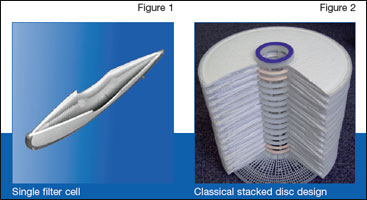
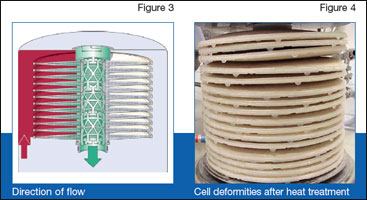
Construction technology of SUPRAdisc II modules
SUPRAdisc II depth filter modules (Figure 5) incorporate a double separator concept.
- Alternating outside separators, discs of depth media, and inside separators are affixed to a rigid polypropylene core until the desired height is achieved.
- Two techniques are used to connect the separators:
- For the 287 mm (12 inch) diameter modules, the unique Clip-Seal Interlock is created using a hydraulic ram to apply pressure and snap and lock the outside to the inside separators. Each disc of filter media is thus sealed in between the separators.
- For the 410 mm (16 inch) diameter modules, the inside/outside separators are connected by ultrasonic welding.
- Locking end caps are then applied to the center core, creating a complete module.
Design features of SUPRAdisc II modules
The unique separator design provides both upstream and downstream support of the filter media. The media is sealed inside a polypropylene cage assembly and is no longer exposed. The unique Clip-Seal Interlock and the welded design connects the outside to the inside separators resulting in an extremely robust design (Figures 6,7).
Each sheet of filtration media is individually sealed and separated. Depth sheets cannot come into contact with each other, eliminating blinding of the media.
Due to the separator channels, SUPRAdisc II depth filter modules have close to a 100 % effective filtration area that is dimensionally stable during shipment and handling, filtration and removal.
Deformation or cell collapse is no longer an issue and sheet damage during use is minimized. Backflushing to regenerate the modules is now possible.
Backflushing SUPRAdisc II modules
With the use of a backflush set consisting of supporting discs and intermediate distance discs (Figure 8), modules can be backflushed either with water or the product to remove contaminants and prolong its life.
For more detailed information on backflushing and the availability of backflush sets, please contact Pall.
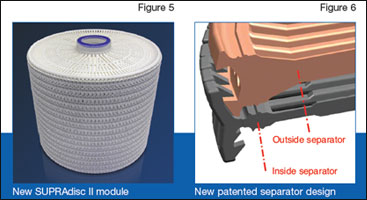
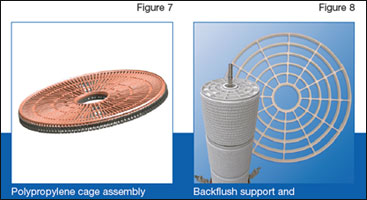
Benefits of SUPRAdisc II modules
SUPRAdisc II depth filter module housings offer a multitude of benefits that overcome the disadvantages of the classical stacked disc design (Figures 9, 10, 11). These benefits result in significant cost savings.
- Longer onstream life due to highest utilization of the filter sheet area, no blinding of filter surfaces, open design of the separators, optimized drainage and distribution of incoming fluid to each filter sheet via the outside separator.
- Repeated use is possible due to the regenerability of the modules with backflushing.
- Higher operational security due to resilience against vacuum or backpressure shocks. Additionally, there is no cell or module deformation due to hot operation or sanitization and steaming.
- Better handling before and after the operation due to robust design and the protection of filter media from exposure and damage.
- Higher yields, as rest filtration in reverse flow mode, are possible.
- High filtrate quality, without chance of bypass, due to module design and the use of proven and reliable filter media recipes.
- Higher microbial safety due to closed design.
- Significant reduction in oxygen uptake due to minimized system volume and closed housing design.
SUPRAdisc II housings
Pall has used design, cost, and industry expectation as the creative foundation of our depth filter technology. In combination with our stringent manufacturing standards, we have developed a line of depth filter module housings for food and beverage applications.
Pall Corporation has used design, cost, and industry expectation as the creative foundation of our depth filter technology. In combination with our stringent manufacturing standards, we have developed a line of depth filter module housings for food and beverage applications.
The modules available for on-line purchase are shown in the table below. For additional sizes and configurations, please contact a Pall representative. Accessories are sold separately.
| Material | Housing Diameter | Number of Modules | Inlet/Outlet Connection | Housing Volume |
| WSFZ162F31UT5J | 16 in | 2 | 2 in Triclamp | 105 L |
| WSFZ164F31UT5J | 16 in | 4 | 2 in Triclamp | 191 L |
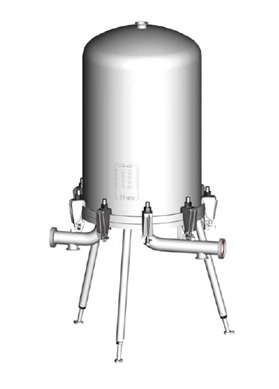
SUPRAdisc II backflush adaptor kit
SUPRAdisc II depth filter modules can be multi-cycle water flushed in a forward flow direction, enabling a very good release of contaminants soluble in hot water without denaturing proteins that could cause premature plugging of the modules. The modules can additionally be regenerated by backflushing multiple times to release the surface load of hop particulates and residues, yeast and other particles. Flushing in forward and reverse direction is a common operation used in breweries to increase the overall throughput of the modules.
For breweries using reverse flushing as part of their regeneration process, Pall recommends backflush devices for additional support. Backflush support kits are available for online purchase:
Part number : 20041342
Description: Backflush support set for WSFZ Series filter housings
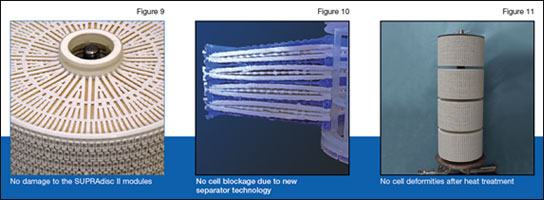
- Particle Removal
- Polishing Filtration
- Final Filtration
SUPRAdisc II filter media options
K Series
With 13 different grades of permeability, the K Series modules represent Pall's standard depth filter series. These sheets consist of a cellulose matrix with very fine kieselguhr (diatomaceous earth or DE) mixtures and perlite, as filtration-active substances.
Table 1: Removal performance of K Series Modules| Sheet Media Type | Application | Examples of use |
| EKS, EK1, EK, KS 50, KS 80 |
Fine Filtration | Microorganism reduction in beer with moderate to high microbial load |
| K100, K150, K200, K250, K300 |
Polishing Filtration |
Microorganism reduction in beer with low microbial load Fine filtration of beer and yeast removal Fine filtration of beer following DE prefiltration Polishing filtration of beer |
| K700, K800, K900 | Coarse Filtration |
Clarification of beer |
These modules are used for a wide range of very fine to coarse filtration in many food and beverage applications.
Select the language below:
| SUPRAdisc™ II Depth Filter Modules Installation - English |
| SUPRAdisc™ II Depth Filter Modules - English |
SUPRAdisc II Standard Range
This is a guide to the Part Numbering structure only. For specific options, please contact Pall
Part Number:
200 [Table 1] [Table 2] [Table 3] [Table 4] [Table 5] W
Example Part Number:
200 X100 C 232 S P W
See bold reference codes in tables
Table 1
| Code | Sheet Media Type |
| K Series | |
| XEKS | EKS |
| XEK1 | EK1 |
| XEKO | EK |
| X050 | KS50 |
| X080 | KS80 |
| X100 | K100 |
| X150 | K150 |
| X200 | K200 |
| X250 | K250 |
| X300 | K300 |
| X700 | K700 |
| X800 | K800 |
| X900 | K900 |
Table 2
| Code | Adapter | Nominal Height |
| C | Flat gasket | 272 mm (10.7 in) |
Table 3
| Code | Nominal Diameter | Number of Sheets | Area |
| 232 | 287 mm (12 in) | 32 | 1.8 m2 (19.4 ft2) |
| 440 | 410 mm (16 in) | 40 | 5 m2 (54 ft2) |
Alternative module dimensions are available on request.
Table 4
| Code | O-ring Seal Options |
| S | Silicone (standard) |
| E | EPDM |
Seal materials meet FDA requirements for food contact use detailed in 21 CFR Section 177.2600. Alternative materials are available on request.
Table 5
| Code | Cage Assembly |
| P | Polypropylene |
Earn 10% off* your next order online by leaving a review of this product. Please login to your account to leave a review. We appreciate and value your feedback.
*Subject to Terms and Conditions.



